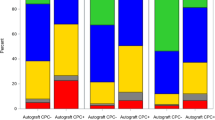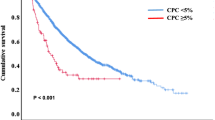Abstract
Plasma cell myeloma, characterized by clonally aberrant plasma cells that produce abnormal monoclonal Igs, is the most common indication for autologous hematopoietic progenitor cell transplantation (AHPCT) in North America. We observed appearance of new monoclonal gammopathies different from the original protein in the post-AHPCT setting and termed this condition ‘secondary MGUS’ (monoclonal gammopathy of undetermined significance). Hence, we performed a retrospective, single institution review of serum protein electrophoresis/immunofixation electrophoresis data in 92 AHPCT recipients from the period 2000–2009. In all, 22 of 92 patients (24%) undergoing AHPCT met criteria for secondary MGUS. Contrary to previous studies, often referred to as ‘abnormal protein banding,’ we did not observe this condition as a favorable prognostic indicator in affected patients when compared with the control group (P=0.686). However, we did note that a subgroup of the study cohort who developed secondary MGUS after a prolonged latency (>10 months) had an improved median OS compared with the remainder of the study cohort (75 months vs 41 months, P=0.005). As there have been significant advancements in understanding the pathobiology and clinical significance of MGUS, we believe that secondary MGUS merits dedication of resources for investigation to determine its true clinical relevance, prognostic value and pathophysiology.
This is a preview of subscription content, access via your institution
Access options
Subscribe to this journal
Receive 12 print issues and online access
$259.00 per year
only $21.58 per issue
Buy this article
- Purchase on Springer Link
- Instant access to full article PDF
Prices may be subject to local taxes which are calculated during checkout




Similar content being viewed by others
References
Landgren O, Kyle RA, Pfeiffer RM, Katzmann JA, Caporaso NE, Hayes RB et al. Monoclonal gammopathy of undetermined significance (MGUS) consistently precedes multiple myeloma: a prospective study. Blood 2009; 113: 5412–5417.
Weiss BM, Abadie J, Verma P, Howard RS, Kuehl WM . A monoclonal gammopathy precedes multiple myeloma in most patients. Blood 2009; 113: 5418–5422.
Kumar SK, Rajkumar SV, Dispenzieri A, Lacy MQ, Hayman SR, Buadi FK et al. Improved survival in multiple myeloma and the impact of novel therapies. Blood 2008; 111: 2516–2520.
Gertz MA, Kumar S, Lacy MQ, Dispenzieri A, Dingli D, Hayman SR et al. Stem cell transplantation in multiple myeloma: impact of response failure with thalidomide or lenalidomide induction. Blood 2010; 115: 2348–2353; quiz 2560.
Giralt S, Stadtmauer EA, Harousseau JL, Palumbo A, Bensinger W, Comenzo RL et al. International myeloma working group (IMWG) consensus statement and guidelines regarding the current status of stem cell collection and high-dose therapy for multiple myeloma and the role of plerixafor (AMD 3100). Leukemia 2009; 23: 1904–1912.
Durie BG, Salmon SE . A clinical staging system for multiple myeloma. Correlation of measured myeloma cell mass with presenting clinical features, response to treatment, and survival. Cancer 1975; 36: 842–854.
Lazarus HM, Sommers SR, Arfons LM, Fu P, Ataergin SA, Kaye NM et al. Spontaneous autologous graft-versus-host disease in plasma cell myeloma autograft recipients: Flow cytometric analysis of hematopoietic progenitor cell grafts. Biol Blood Marrow Transplant 2011; 17: 970–978.
Kaplan EL, Meier P . Non-parametric estimation from incomplete observations. J Am Stat Assoc 1958; 53: 457–481.
Cox DR . Regression models and life tables (with discussion). J Royal Stat Soc Series B 1972; 34: 188–220.
Maisnar V, Tichy M, Smolej L, Zak P, Radocha J, Palicka V et al. Isotype class switching after transplantation in multiple myeloma. Neoplasma 2007; 54: 225–228.
Zent CS, Wilson CS, Tricot G, Jagannath S, Siegel D, Desikan KR et al. Oligoclonal protein bands and Ig isotype switching in multiple myeloma treated with high-dose therapy and hematopoietic cell transplantation. Blood 1998; 91: 3518–3523.
Hovenga S, de Wolf JT, Guikema JE, Klip H, Smit JW, Smit Sibinga CT et al. Autologous stem cell transplantation in multiple myeloma after VAD and EDAP courses: a high incidence of oligoclonal serum Igs post transplantation. Bone Marrow Transplant 2000; 25: 723–728.
Hall SL, Tate J, Gill D, Mollee P . Significance of abnormal protein bands in patients with multiple myeloma following autologous stem cell transplantation. Clin Biochem Rev 2009; 30: 113–118.
Alejandre ME, Madalena LB, Pavlovsky MA, Facio ML, Corrado C, Milone G et al. Oligoclonal bands and immunoglobulin isotype switch during monitoring of patients with multiple myeloma and autologous hematopoietic cell transplantation: a 16-year experience. Clin Chem Lab Med 2010; 48: 727–731.
Sucak G, Suyani E, Ozkurt ZN, Yegin ZA, Aki Z, Yagci M . Abnormal protein bands in patients with multiple myeloma after haematopoietic stem cell transplantation: does it have a prognostic significance? Hematol Oncol 2010; 28: 180–184.
Wadhera RK, Kyle RA, Larson DR, Dispenzieri A, Kumar S, Lazarus HM et al. Incidence, clinical course, and prognosis of secondary monoclonal gammopathy of undetermined significance in patients with multiple myeloma. Blood 2011; 118: 2985–2987.
Mitus AJ, Stein R, Rappeport JM, Antin JH, Weinstein HJ, Alper CA et al. Monoclonal and oligoclonal gammopathy after bone marrow transplantation. Blood 1989; 74: 2764–2768.
Author information
Authors and Affiliations
Corresponding author
Ethics declarations
Competing interests
The authors declare no conflict of interest.
Rights and permissions
About this article
Cite this article
Manson, G., Campagnaro, E., Balog, A. et al. Secondary MGUS after autologous hematopoietic progenitor cell transplantation in plasma cell myeloma: a matter of undetermined significance. Bone Marrow Transplant 47, 1212–1216 (2012). https://doi.org/10.1038/bmt.2011.244
Received:
Revised:
Accepted:
Published:
Issue Date:
DOI: https://doi.org/10.1038/bmt.2011.244
Keywords
This article is cited by
-
Percorso di laboratorio raccomandato nella diagnosi, prognosi e follow-up delle gammopatie monoclonali
La Rivista Italiana della Medicina di Laboratorio - Italian Journal of Laboratory Medicine (2017)



